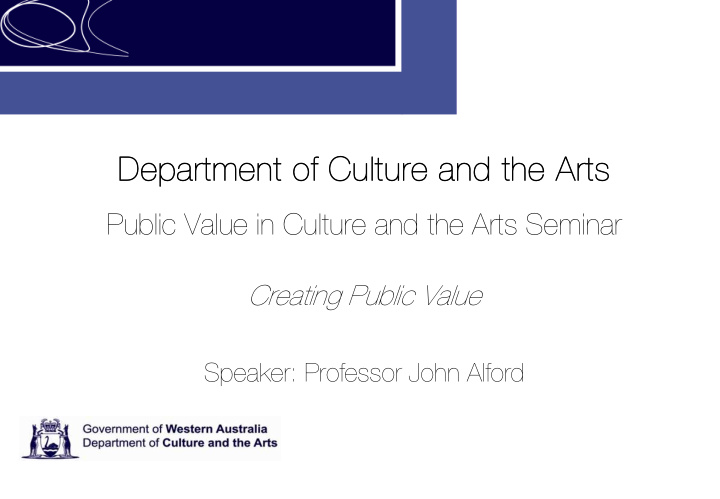



Department of Culture and the Arts Department of Culture and the Arts Public Value in Culture and the Arts Seminar Creating Public Value Speaker: Professor John Alford
Public value in culture and the arts Public value in culture and the arts John Alford 9 December 2010
Public and private value Public and private value A. Citizenry Receives public value B. Client roles Receive � Paying customers private value � Beneficiaries
Some types of public value Some types of public value Type of value Examples Pre-conditions for the market / social order Personal security Police, courts, prisons, currency, etc Contract enforcement Property rights Remedying market failure Public goods. Defence, flood control works. Countering / mitigating externalities. Pollution control, public health regulation. Remedying imperfect market Accreditation of educational courses, registration of information. doctors . Regulating natural monopoly. Regulator-General in power industry. Macroeconomic management. Treasury, Reserve Bank. Meeting needs where markets don’t Education, health. exist (merit goods). Upholding / promoting equity Distributional equity. Welfare benefits, access to education. Procedural equity. Ombudsman, administrative appeals.
Some types of public value Some types of public value Type of value Examples Pre-conditions for the market / social order Personal security Police, courts, prisons, currency, etc Contract enforcement Property rights Remedying market failure Public goods. Defence, flood control works. Countering / mitigating externalities. Pollution control, public health regulation. Remedying imperfect market Accreditation of educational courses, registration of information. doctors . Regulating natural monopoly. Regulator-General in power industry. Macroeconomic management. Treasury, Reserve Bank. Meeting needs where markets don’t Education, health. exist (merit goods). Upholding / promoting equity Distributional equity. Welfare benefits, access to education. Procedural equity. Ombudsman, administrative appeals.
Inputs Processes Outputs Outcomes Inputs Processes Outputs Outcomes
The ‘three circles’ model The ‘three circles’ model Authority Legitimacy Authorising Pol.support Credibility environment Etc Purpose Value Mission • private Goals • public Objectives Etc Staff Productive Skills capacity Technology • internal Contractors • external Volunteers Etc
The authorising environment The authorising environment Media Citizenry Dept of Finance PM/Cabinet Parliamen Defence t Minister Dept State hospital DVA systems RSL Other veterans’ Doctors Veterans organisations
Forms of authorisation Forms of authorisation • Statutes/constitutions. • Ministerial directions/requests. • Court decisions. • Managerial instructions. • Professional/expert judgment. • Community support.
The authorising environment The authorising environment Media Citizenry Dept of Finance PM/Cabinet Parliamen Defence t Minister Dept State hospital DVA systems RSL Other veterans’ Doctors Veterans organisations
Productive capacity Productive capacity • Internal/organisational capabilities: Staff (skills, structure, systems, culture, etc) – PRODUCTION. • External capabilities: Contractors, partners, volunteers, clients, regulatees, etc – CO-PRODUCTION
Recommend
More recommend